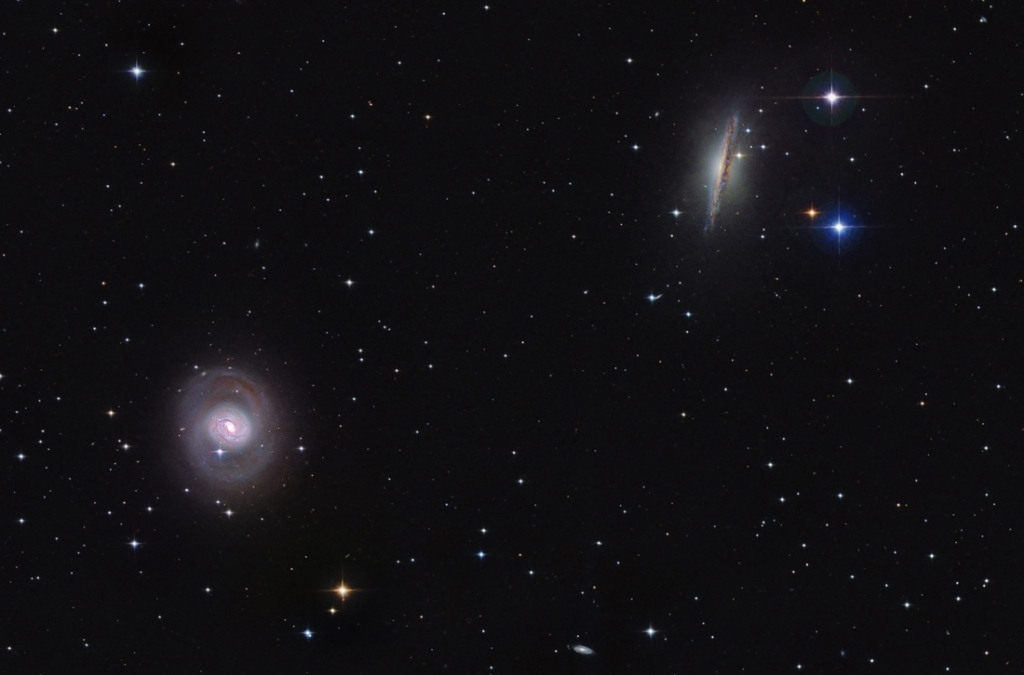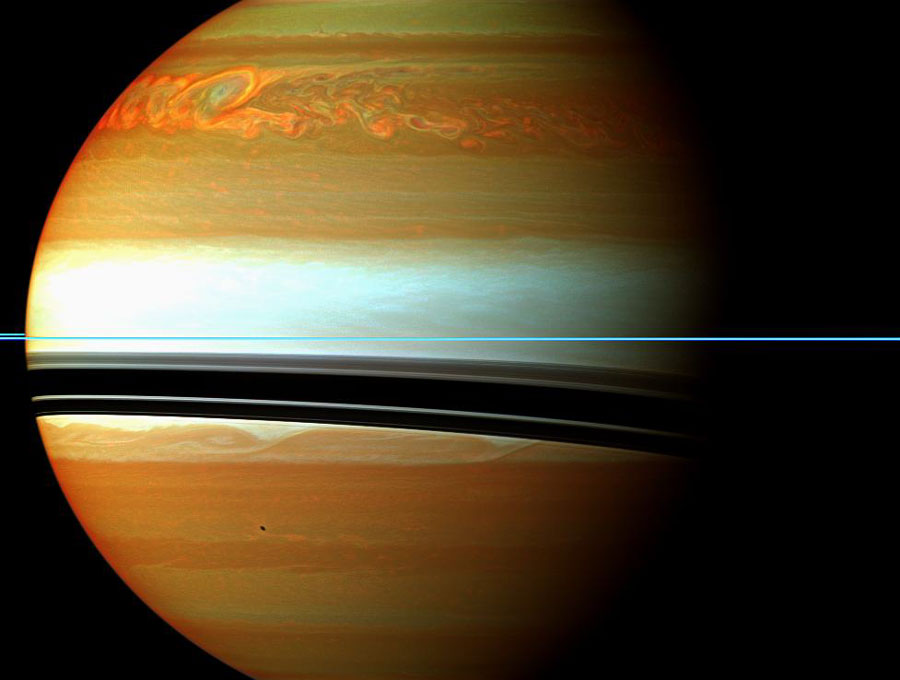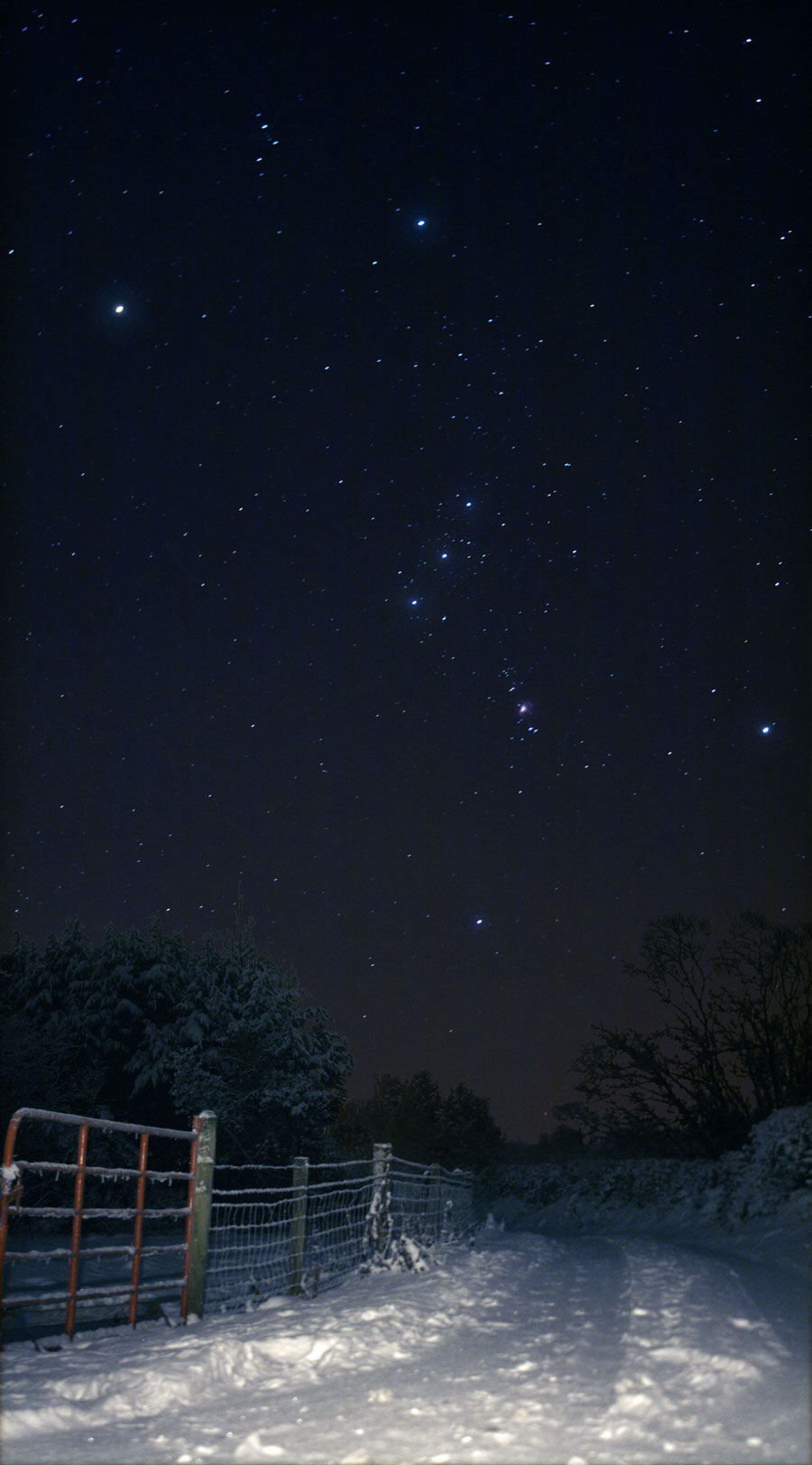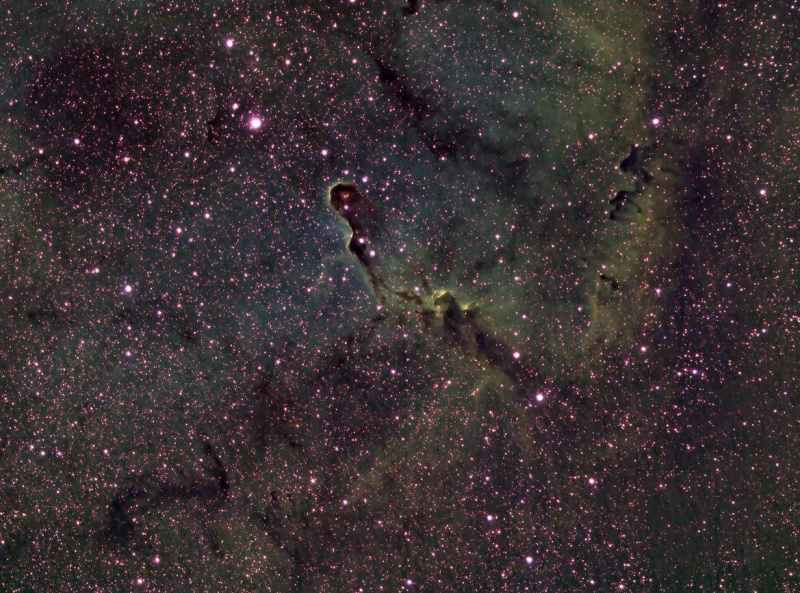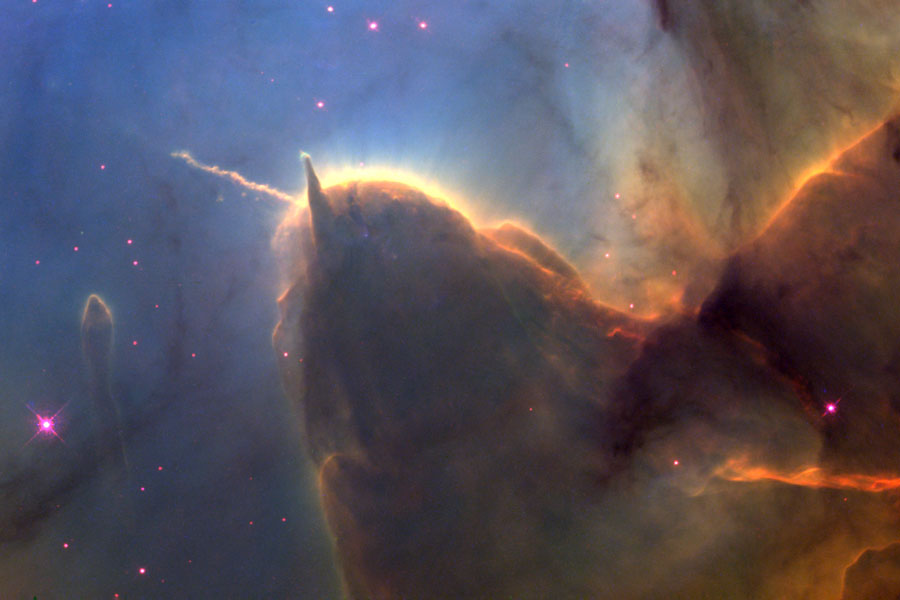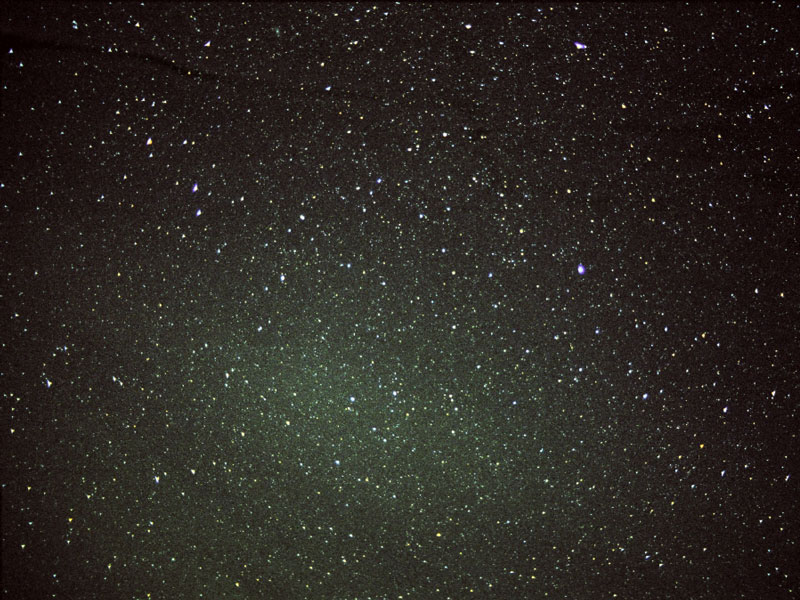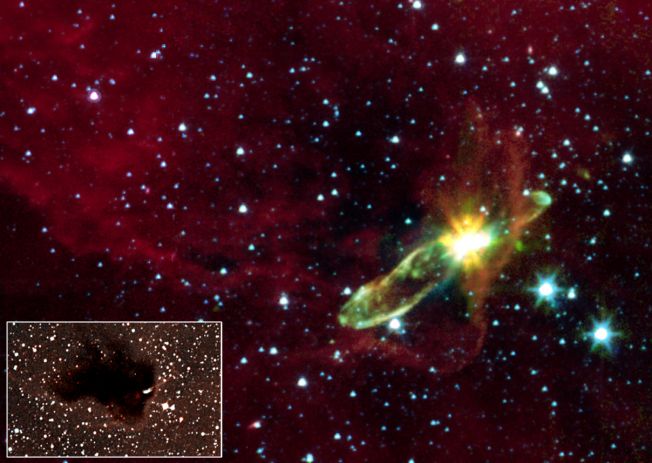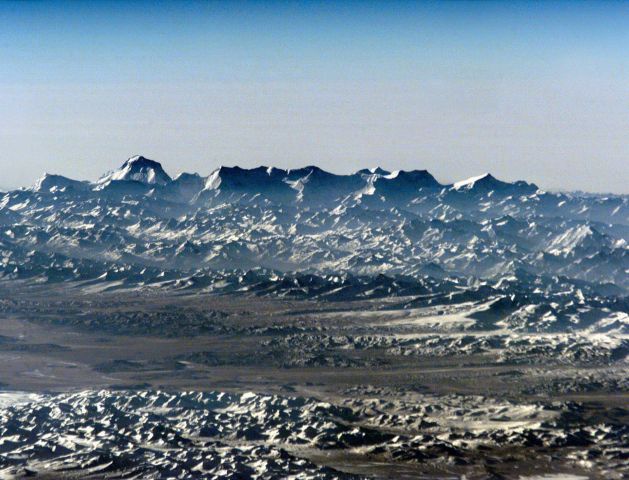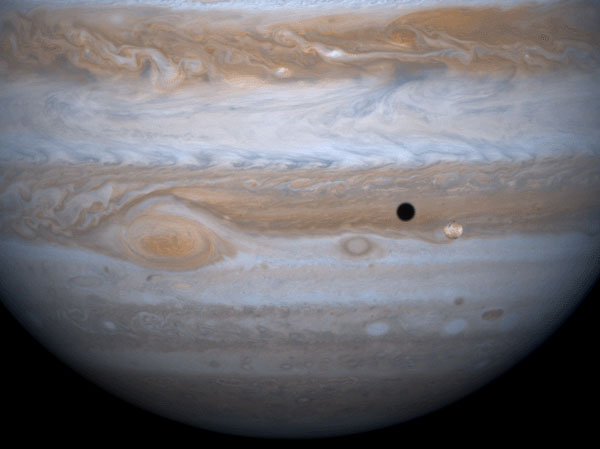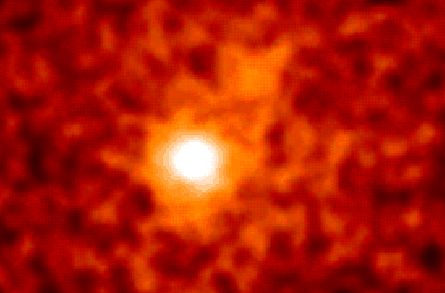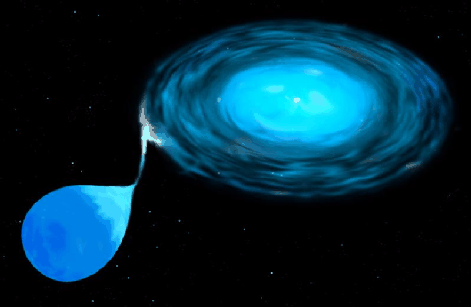| << Previous | Index | Next >> |
2014 At the top right, large spiral galaxy NGC 1055 joins spiral Messier 77 in this sharp cosmic view toward the aquatic constellation Cetus. The narrowed, dusty appearance of edge-on spiral NGC 1055 contrasts nicely with the face-on view of M77's bright nucleus and spiral arms. Both over 100,000 light-years across, the pair are dominant members of a small galaxy group about 60 million light-years away. At that estimated distance, M77 is one of the most remote objects in Charles Messier's catalog and is separated from fellow island universe NGC 1055 by at least 500,000 light-years. The field of view is about the size of the full Moon on the sky and includes colorful foreground Milky Way stars (with diffraction spikes) along with more distant background galaxies.
2013
[imghover6=http://apod.nasa.gov/apod/image/1312/M3 ... ced900.jpg]http://apod.nasa.gov/apod/image/1312/m3 ... Ha900c.jpg[/imghover6]Image Credit & Copyright: Adam Block, Mt. Lemmon SkyCenter, U. Arizona
2012 Makemake is one of the largest objects known in the outer Solar System. Pronounced MAH-kay MAH-kay, this Kuiper belt object is about two-thirds the size of Pluto, orbits the Sun only slightly further out than Pluto, and appears only slightly dimmer than Pluto. Makemake, however, has an orbit much more tilted to the ecliptic plane of the planets than Pluto. Discovered by a team led by Mike Brown (Caltech) in 2005, the outer Solar System orb was officially named Makemake for the creator of humanity in the Rapa Nui mythology of Easter Island. In 2008, Makemake was classified as a dwarf planet under the subcategory plutoid, making Makemake the third cataloged plutoid after Pluto and Eris. Makemake is known to be a world somewhat red in appearance, with colors indicating it is likely covered with patchy areas of frozen methane. No images of Makemake's surface yet exist, but an artist's illustration of the distant world is shown above. Careful monitoring of the brightness drop of a distant star recently eclipsed by Makemake indicates that the dwarf planet has little atmosphere.
2011 It is one of the largest and longest lived storms ever recorded in our Solar System. First seen late last year, the above cloud formation in the northern hemisphere of Saturn started larger than the Earth and soon spread completely around the planet. The storm has been tracked not only from Earth but from up close by the robotic Cassini spacecraft currently orbiting Saturn. Pictured above in false colored infrared in February, orange colors indicate clouds deep in the atmosphere, while light colors highlight clouds higher up. The rings of Saturn are seen nearly edge-on as the thin blue horizontal line. The warped dark bands are the shadows of the rings cast onto the cloud tops by the Sun to the upper left. A source of radio noise from lightning, the intense storm may relate to seasonal changes as spring slowly emerges in the north of Saturn.
2010 Orion always comes up sideways ... and was caught in the act earlier this month by over a snowy landscape in Donegal, Ireland. To compose this serene picture, the photographer found a picturesque setting to the east, waited until after sunset, and then momentarily lit the foreground with a flashlight. The three bright stars in Orion's belt stand in a nearly vertical line above the snow covered road at the bottom. Hanging from his belt, the stars and nebulae of the Hunter's sword are visible lower and to the right. Yellow-orange Betelgeuse is the brightest star on the image left. As winter progresses in Earth's northern hemisphere, Orion will rise earlier and so appear continually higher in the sky at sunset.
2009
2008 Like an illustration in a galactic Just So Story, the Elephant's Trunk Nebula winds through the emission nebula and young star cluster complex IC 1396, in the high and far off constellation of Cepheus. Of course, this cosmic elephant's trunk is over 20 light-years long. This false-color composite was recorded through narrow band filters that transmit the light from hydrogen (in green), sulfur (in red), and oxygen (in blue) atoms in the region. The resulting image highlights the bright swept-back ridges that outline pockets of cool interstellar dust and gas. Such embedded, dark, tendril-shaped clouds contain the raw material for star formation and hide protostars within the obscuring cosmic dust. Nearly 3,000 light-years distant, the relatively faint IC 1396 complex covers a large region on the sky, spanning over 5 degrees. This dramatic close-up covers a 2 degree wide field, about the size of 4 Full Moons.
2007 Dust pillars are like interstellar mountains. They survive because they are more dense than their surroundings, but they are being slowly eroded away by a hostile environment. Visible in the above picture is the end of a huge gas and dust pillar in the Trifid Nebula, punctuated by a smaller pillar pointing up and an unusual jet pointing to the left. The pink dots are newly formed low-mass stars. A star near the small pillar's end is slowly being stripped of its accreting gas by radiation from a tremendously brighter star situated off the above picture to the upper right. The jet extends nearly a light-year and would not be visible without external illumination. As gas and dust evaporate from the pillars, the hidden stellar source of this jet will likely be uncovered, possibly over the next 20,000 years.
2006 If you look carefully enough, you can even see the glow of the Sun in the opposite direction. At night this glow is known as the gegenschein (German for "counter glow"), and can be seen as a faint glow in an extremely dark sky. The gegenschein is sunlight back-scattered off small interplanetary dust particles. These dust particles are millimeter sized splinters from asteroids and orbit in the ecliptic plane of the planets. Pictured above, the gegenschein is seen superposed toward the constellation of Pisces. The gegenschein is distinguished from zodiacal light by the high angle of reflection. During the day, a phenomenon similar to the gegenschein called the glory can be seen in reflecting air or clouds opposite the Sun from an airplane.
2005 This huge puff ball was once a star. One thousand years ago, in the year 1006, a new star was recorded in the sky that today we know was really an existing star exploding. The resulting expanding gas from the supernova is still visible with telescopes today, continues to expand, and now spans over 70 light years. SN 1006 glows in every type of light. The above image of SN 1006 was captured by the orbiting Chandra Observatory in X-ray light. Even today, not everything about the SN 1006 is understood, for example why particle shocks that produce the bright blue filaments are only visible at some locations. SN 1006 is thought to have once been a white dwarf that exploded when gas being dumped onto it by its binary star companion caused it to go over the Chandrasekhar limit. Foreground stars are visible that have nothing to do with the supernova.
2004 In the center of a swirling whirlpool of hot gas is likely a beast that has never been seen directly: a black hole. Studies of the bright light emitted by the swirling gas frequently indicate not only that a black hole is present, but also likely attributes. The gas surrounding GRO J1655-40, for example, has been found to display an unusual flickering at a rate of 450 times a second. Given a previous mass estimate for the central object of seven times the mass of our Sun, the rate of the fast flickering can be explained by a black hole that is rotating very rapidly. What physical mechanisms actually cause the flickering -- and a slower quasi-periodic oscillation (QPO) -- in accretion disks surrounding black holes and neutron stars remains a topic of much research.
2003 High-speed outflows of molecular gas from a young stellar object glow in infrared light, revealing themselves in this recent false-color image from the Spitzer Space Telescope. Cataloged as HH (Herbig-Haro) 46/47 the infrared source is lodged within a dark nebula or Bok globule - near the lower right corner of the dark nebula in the optical inset - that is largely opaque when viewed in visible light. The energetic outflow features extend for nearly a light-year, burrowing into the dark interstellar material, and are attributed to early stages in the life of a sun-like star. They may well represent a phase of our own Sun's evolution which took place some 4.5 billion years ago, along with the formation of our solar system from a circumstellar disk. A tantalizing object to explore with Spitzer's infrared capabilities, this young star system is relatively nearby, located only some 1,140 light-years distant in the nautical constellation Vela.
2002 Where is the best place on Earth to find meteorites? Although meteors fall all over the world, they usually just sink to the bottom of an ocean, are buried by shifting terrain, or are easily confused with terrestrial rocks. At the bottom of the Earth, however, in East Antarctica, huge sheets of blue ice remain pure and barren. When traversing such a sheet, a dark rock will stick out. These rocks have a high probability of being true meteorites -- likely pieces of another world. An explosion or impact might have catapulted these meteorites from the Moon, Mars, or even an asteroid, yielding valuable information about these distant worlds and our early Solar System. Small teams of snowmobiling explorers so far have found thousands. Pictured above, ice-trekkers search a field 25-kilometers in front of Otway Massif in the Transantarctic Mountain Range during the Antarctic summer of 1995-1996.
2001 This stunning aerial view shows the rugged snow covered peaks of a Himalayan mountain range in Nepal. The seventh-highest peak on the planet, Dhaulagiri, is the high point on the horizon at the left while in the foreground lies the southern Tibetan Plateau of China. But, contrary to appearances, this picture wasn't taken from an airliner cruising at 30,000 feet. Instead it was taken with a 35mm camera and telephoto lens by the Expedition 1 crew aboard the International Space Station -- orbiting 200 nautical miles above the Earth. The Himalayan mountains were created by crustal plate tectonics on planet Earth some 70 million years ago, as the Indian plate began a collision with the Eurasian plate. Himalayan uplift still continues today at a rate of a few millimeters per year.
2000 Just as planets orbit our Sun, Jupiter's Moons orbit Jupiter. Pictured above is the closest of Jupiter's Galilean Satellites, Io, superposed in front of the giant planet it circles. To the left of Io is a dark spot that is its own shadow. The tremendous complexities that can be seen in Jupiter's banded, swirling atmosphere are being studied and may provide insight as to how Earth's atmosphere behaves. The above true-color contrast-enhanced image was taken two weeks ago by the robot spacecraft Cassini, currently passing Jupiter and on its way to Saturn in 2004. Engineers continue to study the Cassini spacecraft itself to understand why it required more force than normal to turn one of its maneuvering wheels.
1999 The turbulent region West of Jupiter's Great Red Spot is highlighted in this picture constructed from data recorded by the Galileo spacecraft. The image is color coded to show cloud height and thickness; white clouds are high and thick, light blue clouds are high and thin, and reddish clouds are low. The edge of the Red Spot itself appears blue here (lower right) and spans about 10,000 kilometers along the curving limb of the planet (north is up). Westward winds, deflected north by the circulation within the Great Red Spot, collide with Eastward winds at higher latitudes and generate the roiling, Turbulent structures. The largest eddies near the Northwestern edge of the Red Spot are bright, suggesting upward convection and high altitude cloud formation are taking place there.
1998 The bright object in the center of the false color image above is quasar 3C279 viewed in gamma-rays, photons with more than 40 million times the energy of visible light. Like all quasars, 3C279 is a nondescript, faint, star-like object in the visible sky. Yet, in June of 1991 a gamma-ray telescope onboard NASA's orbiting Compton Gamma Ray Observatory unexpectedly discovered that it was one of the brightest objects in the gamma-ray sky. Shortly after this image was recorded the quasar faded from view at gamma-ray energies. Astronomers are still trying to understand what causes these enigmatic objects to flare so violently. Another quasar, 3C273, is faintly visible above and to the right of center.
1997 The turbulent region West of Jupiter's Great Red Spot is highlighted in this recent picture constructed from data recorded by the Galileo spacecraft. The image is color coded to show cloud height and thickness; white clouds are high and thick, light blue clouds are high and thin, and reddish clouds are low. The edge of the Red Spot itself appears blue here (lower right) and spans about 6,600 miles along the curving limb of the planet (north is up). Westward winds, deflected north by the circulation within the Great Red Spot, collide with Eastward winds at higher latitudes and generate the roiling, turbulent structures. The largest eddies near the Northwestern edge of the Red Spot are bright, suggesting upward convection and high altitude cloud formation are taking place there.
1996 Carl Sagan died last Friday at the age of 62. Sagan was the world's most famous astronomer. Among his many activities as a scientist, he contributed to the discovery that the atmosphere of Venus is prohibitively hot and dense, and found evidence that Saturn's moon Titan contains oceans stocked with the building blocks of life. Sagan was an outspoken proponent of the search for extra-terrestrial life, including sending probes to other planets and listening with large radio telescopes for signals from intelligent aliens. Sagan's outstanding ability to explain allowed almost a billion people to better understand the cosmos in which they live.
1995 Our Sun is unusual in that it is alone - most stars occur in multiple or binary systems. In a binary system, the higher mass star will evolve faster and will eventually become a compact object - either a white dwarf star, a neutron star, or black hole. When the lower mass star later evolves into an expansion phase, it may be so close to the compact star that its outer atmosphere actually falls onto the compact star. Such is the case diagrammed above. Here gas from a blue giant star is shown being stripped away into an accretion disk around its compact binary companion. Gas in the accretion disk swirls around, heats up, and eventually falls onto the compact star. Extreme conditions frequently occur on the surface of the compact star as gas falls in, many times causing detectable X-rays, gamma-rays, or even cataclysmic novae explosions. Studying the extreme conditions in these systems tells us about the inner properties of ordinary matter around us.
| << Previous | Index | Next >> |
